Saint Denis Basilica – The Best Way to Visit in the Other Paris
Prior to its terrible fire in 2019 everyone who went to Paris wanted to visit Notre Dame Cathedral, arguably the most famous church in the world, which also made it the most visited. While it was unquestionably beautiful to look at, there were simply too many people inside the church to really appreciate the interior. The proliferation of selfie-taking self absorbed imbeciles who have no regard for others or the sanctity of the place they are visiting was a disgrace, as it is in St. Peter’s in Rome. Add to the mix the explosion of Chinese tourists who had no idea of how to behave and you found yourself wanting to scream “I hate this place!” There is an alternative to having a Peter Finch type break down and that is to visit a place that is older than Notre Dame, far more historically important and will have next to no visitors. I’m talking about Saint Denis Basilica the first gothic cathedral ever built and the depository of the remains of almost every French ruler since Dagobert, the last of the Merovingians.
So you are asking yourself “Why haven’t I heard of this place? What’s the catch?” Well, there is a catch, but only if you make it one. Saint Denis is in ‘The Other Paris”.
The average tourist in Paris will see very few black people or arabs in the areas they want to visit and most that they do see are in the service industry or illegal immigrants selling crap in front of places like the Eiffel Tower. If that tourist is perceptive he/she will see lots of ‘Je suis Charlie’ signs on walls or in the windows of cars, but no sign of the type of people who provoked that response. But they are there – in The Other Paris. The city proper has about two and a half million inhabitants, but beyond that are another eight to ten million souls who rarely venture into the Paris that tourists come to see. They live in huge complexes well outside the traditional arrondisements that you might have noticed as your plane descended into Charles de Gaulle airport and that’s also where Saint Denis Basilica is found.
Come along with me and I’ll show you how to visit St. Denis and how to overcome the somewhat natural fears that a journey into a Paris that few tourists ever see, might engender.
The Story of Saint Denis
The trip starts in Montmartre of all places. This highest hill in Paris once was topped by a Roman temple to the god Mars and in a previous post I opined that the name Montmartre was a corruption that arose from that time and many linguists agree that this is probably the case. However, the usual explanation is that is stands for Mount of the Martyr, the martyr being, of course, Saint Denis. Here’s where the story gets good. Saint Denis was an early Christian in Paris who pissed off the Romans to the point that they cut his head off on Montmartre. Saint Denis was not going to take this lying down so he picked up his head. Here he is doing just that at a spot in Montmartre where the event allegedly occurred.
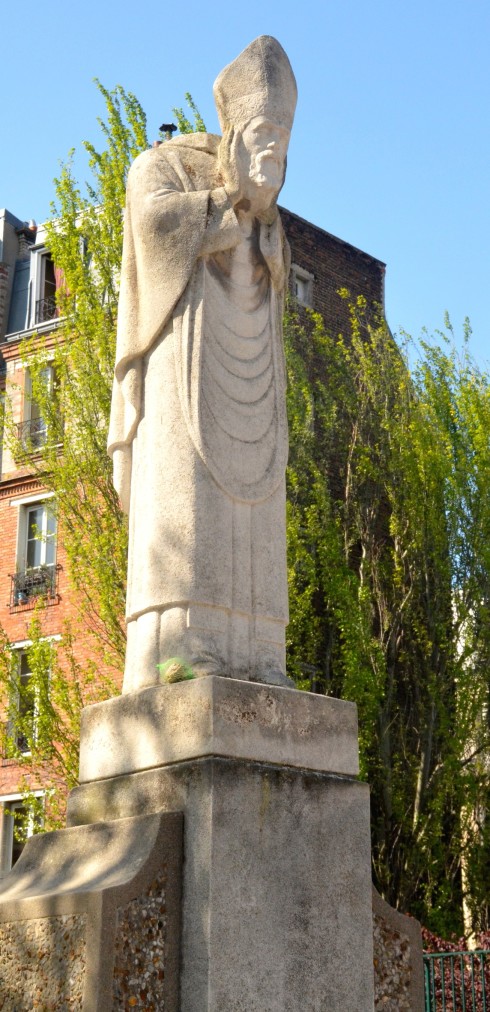
Then he proceeded to go on a walkabout until he got to the present site of St. Denis Basilica, said “That’s it. I’m dead. Build me a church here.” and of course they did. It has been a holy site for over 1600 years. In 639 Dagobert, son of the legendary Clovis, the first Frankish king to convert, started a tradition of burying the monarchs of France at St. Denis. There is no other place in the world that has a collection of past rulers anywhere near as large as St. Denis.
The Other Paris
Back to the other Paris and why Saint Denis has so few visitors. Guidebook writers and publishers do not want to send their readers, almost entirely caucasian or asian, to places that might scare them and that would be a place that is predominated by black faces. If you look at older guide books Saint Denis was a must visit destination and as this area of outer Paris began to change and became non-white it gradually dropped off the charts to the point that it isn’t even mentioned in some guidebooks anymore. It’s also where most of the terrorists came from who attacked their fellow Parisiennes in November, 2015. Well I’m about to find out if there is any reason for not visiting this most historic place.
It is really easy to get to Saint Denis. You just take the ReR D line from Gare du Nord. It takes only about twenty minutes to get there, but don’t make the mistake of getting off at the first stop, Saint Denis Stade du France as we did. You want the second Saint Denis stop. Assuming the reader of this post is not black or arab, you will probably be one of the very few white people on this train. The scenery, if you can call it that, is incredibly bleak, graffiti scrawled and garbage strewn – the nickname of this line is the poubelle or garbage can. Getting out at the right Saint Denis station there is absolutely nothing to indicate that you are just about a half a mile from probably the most important historical site in France. It looks more like you just got off a train in Morocco or maybe Senegal.
We follow the hordes across a bridge and into what I gather is Saint Denis. There are lots of people hawking stuff, but strangely they ignore us. A couple of ingenious types have set up small braziers on top of shopping carts and they are grilling kebabs on them. We come across a sign to the basilica and it is apparent that it is at the end of a long pedestrian street that is thronged with people coming and going or just sitting doing nothing. I don’t feel threatened in any way. They have their business, we have ours. At last I catch a glimpse of the basilica not far away.
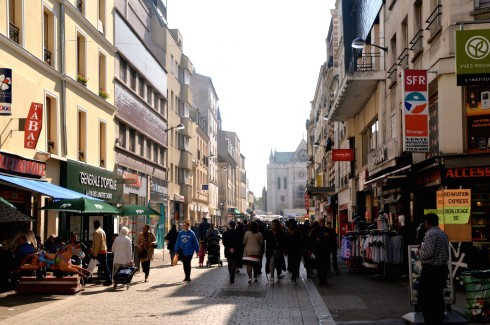
As we get nearer, the makeup of the crowds changes from almost all black to cafe au lait to mostly white as we emerge onto the square before the basilica and I get my first big disappointment; that bane of great monuments – the dreaded scaffolding!
Saint Denis Basilica
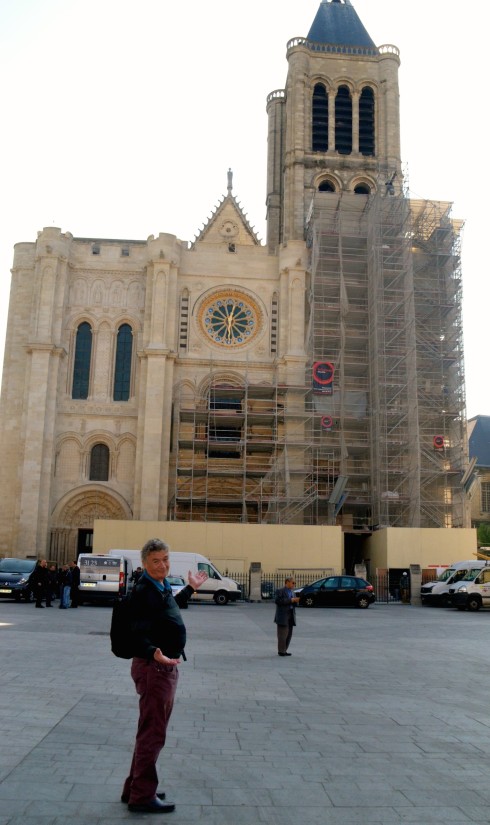
Prior to our visit I did my usual research and watched a Great Courses lecture on the history and highlights of Saint Denis basilica that my sister Anne had purchased as part of a series on gothic cathedrals. I was looking forward to examining the sculptural carvings over the main entrance as these told the story of basically the entire Bible in one quick look. It was quickly apparent that Saint Denis was undergoing a thorough cleaning and restoration that looked like it was probably going to take years. Oh, and that clock wasn’t in the pictures of Saint Denis that were shown on the Great Courses lecture. Apparently it was instilled literally last month and has replaced the rose window for which the basilica was justly famous. Don’t ask me why – I couldn’t find out. Maybe it’s the Parisienne attraction to all things golden.
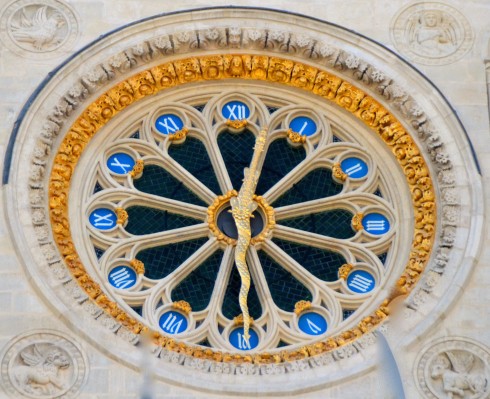
Here is the entrance way in use today. It has been cleaned and looks great in comparison to the areas that remain to be cleaned. It’s hard to believe that such a national treasure could have been left to deteriorate to this extent before someone did something about it. The right side is cut off because of the scaffolding.
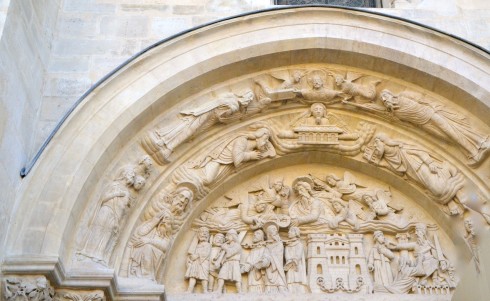
So what’s the big deal about this church as opposed to any of the dozens of other gothic cathedrals in northern Europe? Well how about that it just happened to be the first? From the time Saint Denis became an important religious site there had been buildings on the site including a Benedictine abbey where the remains of Saint Denis and the earliest French kings were kept. In the early 12th century the abbott was a guy called Suger who just happened to be an architectural genius. He decided to build what would have been then an almost impossibly big church by using a design that apparently he came up with on his own. In contrast to the Romanesque churches of the past that were very dark and ornamented largely with mosaics he wanted light and in order to do that he needed windows. But how do you put windows in a structure made entirely out of stone? He started with cross-ribbed vaulting on the ceiling – the first such known use.
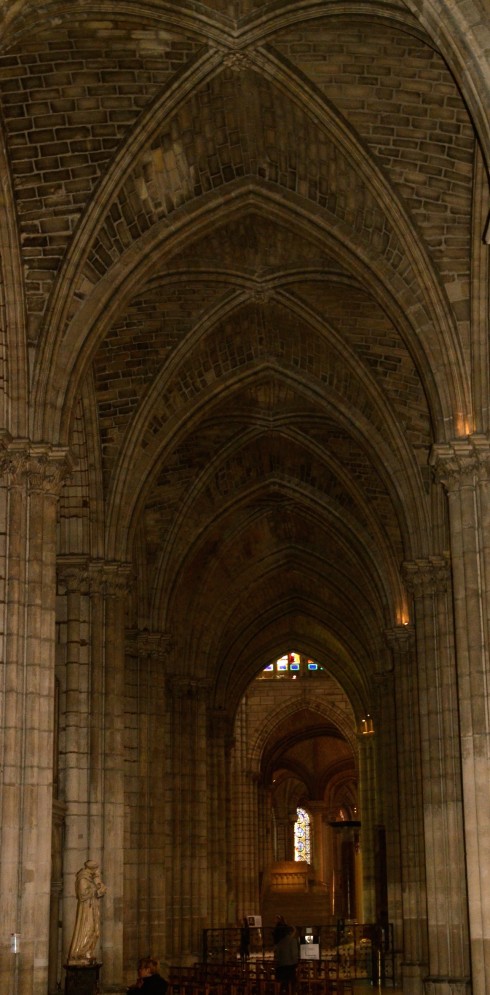
That in turn leads to the ability to distribute weight and use columns to help hold up the structure.
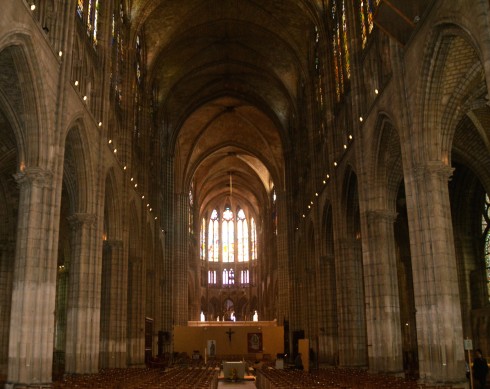
And that means that there is not as much pressure on the side walls so you can put in these.
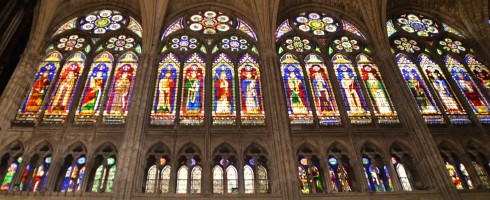
And ultimately this – the first rose window anywhere and to my mind as fine as any in Notre Dame or Chartres.
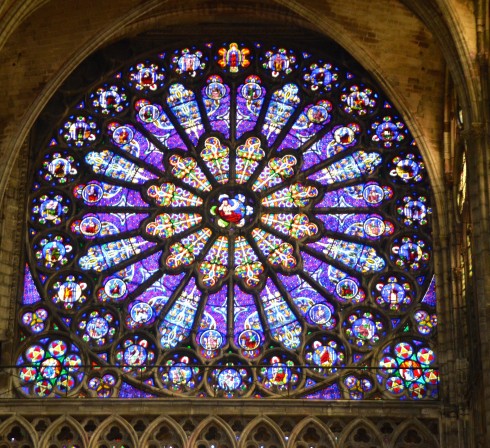
So visiting Saint Denis would be worth it just to see these phenomenal architectural leaps and from the time it opened it did draw people from far and wide to see this cathedral of light. Even Joan of Arc dropped by on a visit in 1429. Tell me she doesn’t remind you of Brienne of Tarth from Game of Thrones.
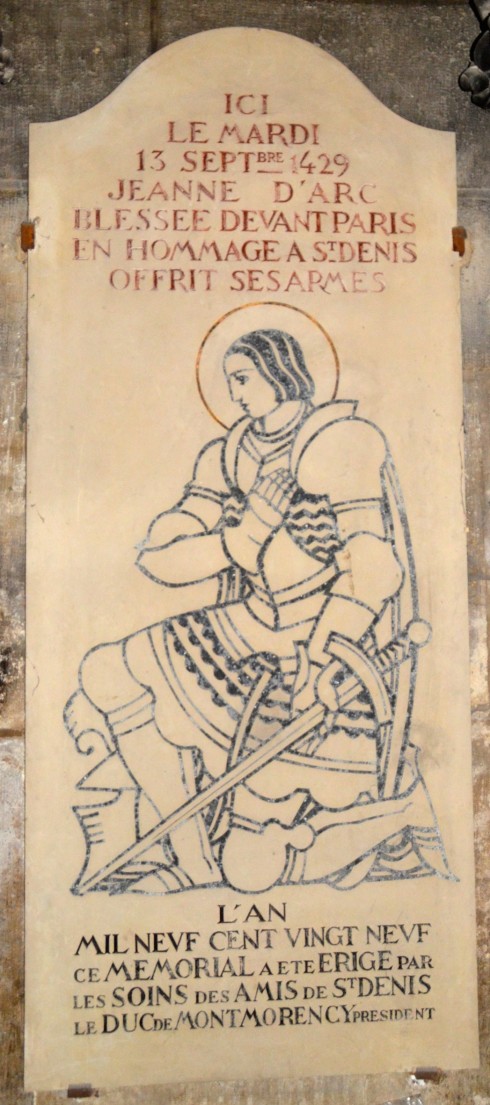
Crypt of Saint Denis
But the basilica itself is only the beginning of Saint Denis’ wonders. While visiting the basilica is free, you do need to pay to enter the crypt and vault. Don’t even consider not doing this. For 10 euros you get an entry fee and an audio guide which contains some very detailed information if you want it.
Before re-entering the basilica proper there is a wooden model of the town of Saint Denis as it existed before the French Revolution when many ecclesiastical buildings were destroyed or vandalized. Note that at that time the basilica had two towers and a spire on the left hand side. This second tower was torn down in the 19th century when, after being hit by lightning, it became structurally unsound. So what you see today is not what the pilgrims of the Middle Ages saw.
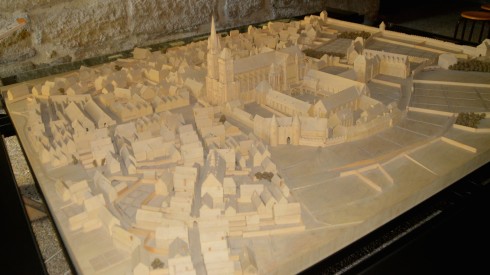
The first thing you see in the vault area are the tombs of Charles V and his queen Joanna of Bourbon. Charles was one of the great French kings and earned the moniker Charles the Wise for the decisions he made that led to a period of considerable success against the English in the 100 Years War. The sculptures of Charles and Joanna are the first known examples of realistic funereal sculpture and are true masterpieces.
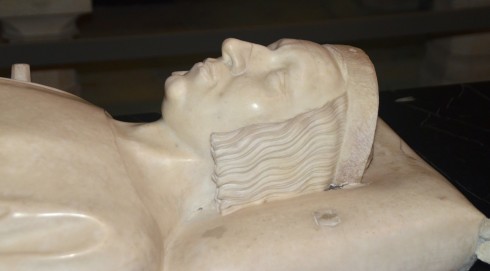
Opposite Charles V is another of the great French kings, Francis I, the instigator of the French Renaissance and great statesman known for his meeting with Henry VIII at the Field of Cloth of Gold summit in Calais in 1520. Now he lies here prostrate with his consort Eleanor of Austria.

After visiting these two tombs you descend into the oldest part of the basilica, the crypt which despite being underground is fairly well lit. Here are the remains of Saint Denis which is currently off limits due to the reconstruction – at least I couldn’t find it. At one time this place held the remains of virtually every French ruler from Dagobert forward, but during the revolution the area was ransacked and all the bones thrown together in a heap. Maybe with the use of DNA they will gradually be able to figure out who’s who, but for now there is nothing to see. That said, there were two graves I absolutely did not expect to see – none other than Louis XVI and Marie-Antoinette. They are the middle two of six royal graves and the light was very low so I apologize for the crappy photos, but they will give you an idea of what they look like.
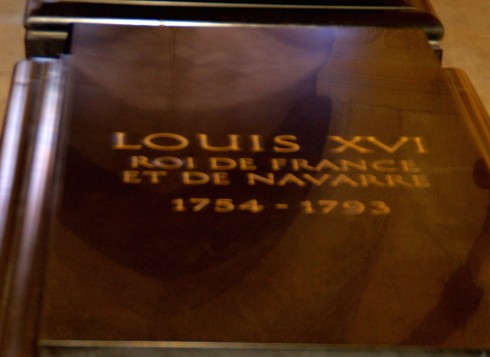
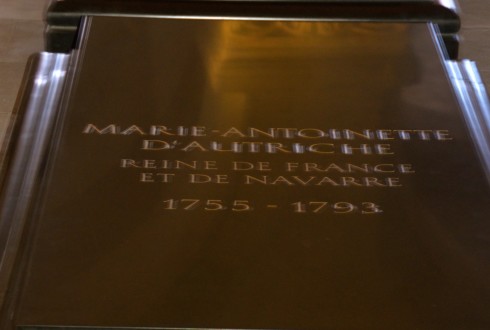
How ironic that Marie-Antoinette who had such a profound disdain for commoners that she famously replied “Let them eat cake” to the plea that the people had no bread, should now lie interred in a city comprised almost entirely of common people. Also that the last people interred here shared the same fate as the first person – decapitation.
The crypt also has some really neat little sculptures like this devil taking a tanning from two good Christians.
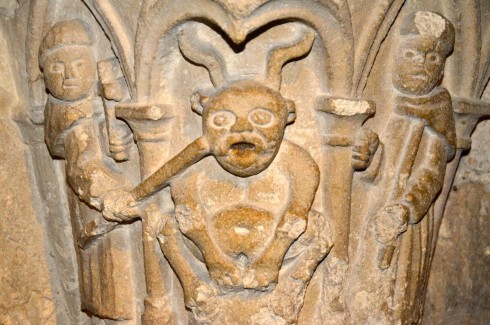
Coming up from the crypt you see a scene that is almost beyond belief – dozens of likenesses of dead kings and queens and other nobility cover floor of this part of the basilica. Some of the tombs are very elaborate and others are simple like this jewel encrusted tomb of Clovis, the founder of the Merovingian dynasty and according to that work of pseudo-history Holy Blood and the Holy Grail a direct descendant of Jesus. It’s hard to believe such a legendary figure even has a tomb, but here he is in this little box.
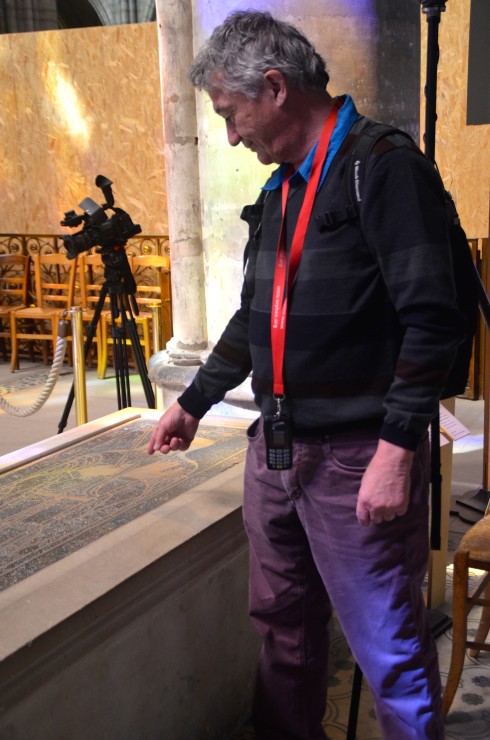
This is Abbot Suger’s chevet which was used to store famous relics like pieces of the True Cross (I always wondered who got sucked into buying pieces of the fake cross) and the bones of famous martyrs and saints.
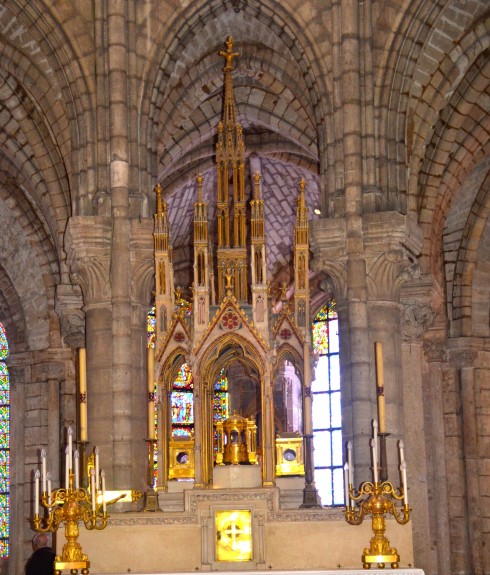
Two of the tombs really stand out, one for the quality of the sculpture and the other for the quality or lack thereof of the people in them. These are the likenesses of Louis XII and Anne de Bretagne depicted as the brochure states dead, naked and flayed. Why flayed I don’t know, as he died from gout. These sculptures, while creepy, are outstandingly realistic.
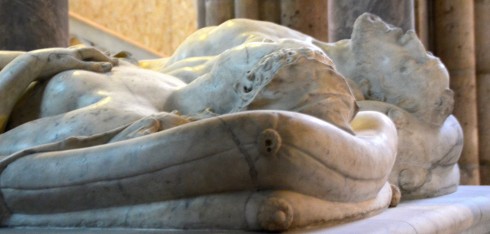
On top of the tomb they are represented during happier times; I guess being alive as opposed to dead is always better.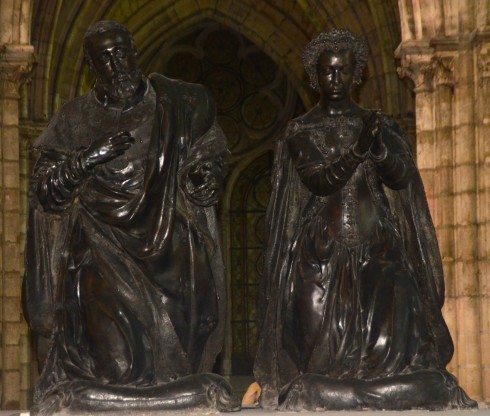
Louis XII and Anne alive
Above this tomb on a higher level is that of another great king Henry II who died as a result of a jousting injury leaving behind three young sons under the tutelage of his wife Catherine de Medici, one of the most evil women of all time. She certainly had the right name to commit the acts she did including instigating the St. Bartholomeow’s Day Massacre of French protestants in 1572 that in turn triggered religious wars throughout Europe that caused the deaths of hundreds of thousands of people. In her time she was as reviled by some as Hitler is today. Here she is in sweet deathful repose. I hope she is rotting in the same hell as all those people she was anxious to send there.
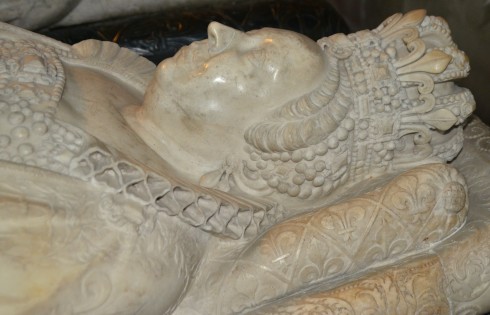
I will end this post on a more upbeat note. At the feet of every dead person here you will find either lions or dogs. Here is one with lions.
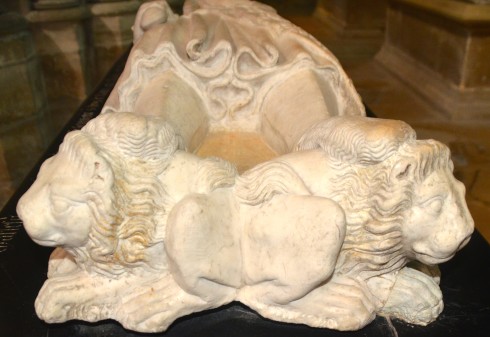
Looking for the answer as to why this practice developed I couldn’t find anything definitive. Here’s one with two dogs that I love because the faces of the dogs are almost identical to the faces of my two miniature poodles – one broad and one narrow.
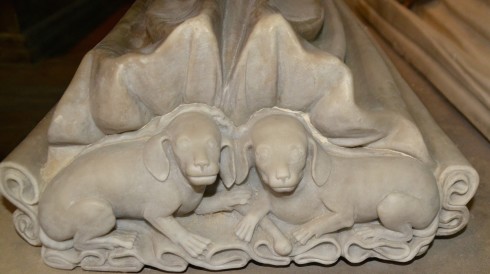
Here they are unshaven.

We exited the basilica after spending about two hours inside and headed across the square to one of the outdoor cafes and had a coffee before retracing our steps to the station. We were back at our apartment in Montmartre in less than an hour. Next I will take a self-guided tour of Montmartre Cemetery. Please join me.

